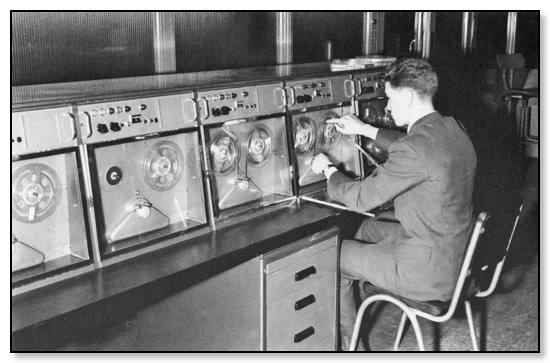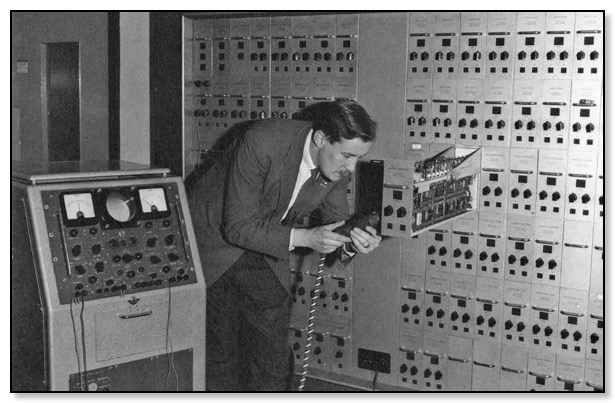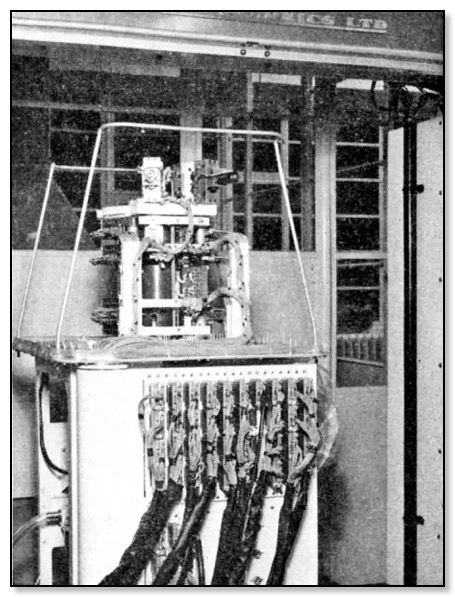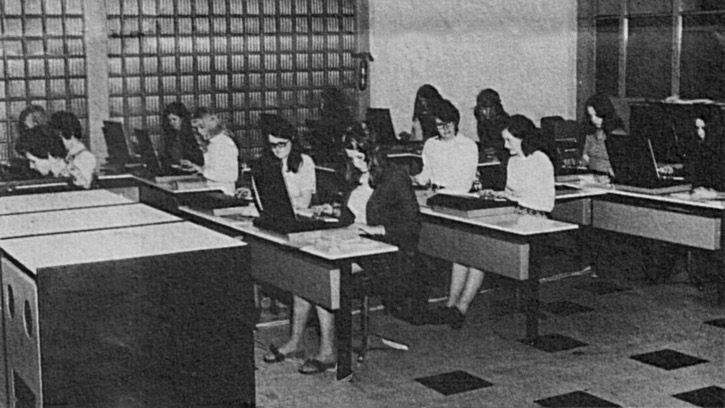Longbridge First Computer

Mr B Payne loads magnetic tape into the tape decks
The application of electronic computers for office procedures in British industry was only just coming to be available for small tasks. So the British Motor Corporation (BMC) decided to send a six-man team to America on a fact-finding tour in 1955.
One of the members of that group was Mr E.H.A Williams, Group Cost Accountant BMC. They visited America for three months, visiting all the main manufacturers of electronic equipment and a large number of motor-car manufacturers. There they saw the ways in which electronic equipment was being used on the shop floor and in the office along with ideas for future applications. 'We were completely convinced that electronics in the office had come to stay.'
On there returned, they were convinced that the company needed to buy computers. The team submitted their ideas and proposals to the management, but it soon learned that there were no manufacturers in England who could at that time make and supply the equipment needed. At this time much of the equipment used in America was made there and impossible to get in England. So Sir Leonard Lord decided to place the contract for a tailor made computer with EMI. So both BMC and EMI worked as a team in the development of electronic computers for office work, and the project was given the code name CP. 407.
In 1958 CP. 407 was installed at Longbridge
Its first task was the payroll for Austin check employees, and was the first electronic computer installed in England. It made full use of magnetic tapes and drum for memory, thereby enabling all the required final data to be obtained from one single processing of a departmental pay-unit.
The task of installing and preparing the computer to operate the payroll was done jointly by EMI. and BMC who had to train staff to operate the machine.
The first task for the computer was calculating the hourly paid employees' pay-roll. Later on EMI. provided a second computer for sales work and production programming – the analysis of orders and sales.
Working out pay for 18,000 without error
The payroll computer has a brain which works out complicated arithmetic at fantastic speeds, calculating each answer in millionths of a second. It has a memory in which it stores thousands of items of information and instructions. And it can do many things simultaneously calculating, checking, costing, whilst printing out 32 comprehensive pay-slips every minute.
But the computer has at least one human characteristic, it likes to receive information and instructions in logical, common sense sequences; it can understand them more easily and work faster. There, however, the comparison ends, for, despite its tremendous capacity for hard and sustained effort, the computer is a machine and a machine cannot think: it has to be told what to do. Here ties the most complicated facet of the payroll application telling the machine what to do devising a programme for it to follow so that it makes not one error in the millions of calculations it does while working out the pay of 18,000 people.
So Varied
As far as pay is concerned, very few of the 18,000 are alike, with rates, bonuses, hours worked, deductions all vary from one person to another And the machine has to be 'put in the picture' about every possible variation in pay that it will encounter. Long before CP. 407 was installed at Longbridge indeed, long before it was delivered, three men began writing the first programme. They were Mr. R. Dixon, then Chief Programme Planner, Mr. G E Phizacklea, Supervisor of the sales computer, and Mr. R. J. Lewis Operational Programmer.
A Punched Card For Every Employee
Computer Programming
Mr. Phizacklea starts the story of the programming: 'Mr. Dixon had experience of costing and time-keeping, Mr. Lewis was a commercial apprentice and had experience of costing, and I had served a post-graduate apprenticeship and had worked on production and in rate-fixing; so although none of us knew much about wages we had a broad knowledge of the system.
The chief difficulty in programming is to have some knowledge of systems and organization and the application of that knowledge, and for programming you either have the aptitude or you don’t being able to cope with mounds of small detail without being snowed under.
The problem of changes, and, once devised, a system is necessarily less flexible. Recently the new State Graduated Pension Scheme cause an addition to the programme, but it was something that could be coped with, said Mr. Phizacklea.
Mr. Dixon explained that its programme has three main jobs research into and analysis of the system, designing the programme, and transposing it into code to read into the computer. The code also contains information for the computer to operate itself automatically throughout all its phases during the processing of the payroll.
We have to analzse and adjust the existing clerical system, striking a balance between those sequences the machine accepts most easily and an efficient shop-floor system for supplying data. We have to gather every conceivable piece of information from all quarters-and as we are in effect listing instructions for the machine to follow we have to build in frequent checks against error. We have to guard against three types of error-human, punch-card, and machine-for occasionally the computer gets one electronic pulse wrong out of the many millions that go through.
A programme consists of about 40 per cent. checks, he said. 'A programmer has to get everything right, and all the research into the subject-matter has to be accurate because the slightest deviation can mean an entirely erroneous result. When the research is completed we draw out what is called the Flowchart-writing all the information and brief instructions in the correct sequence, and it is the studied drawing of the chart that can affect the ultimate processing time needed by the computer. The programme is then coded, transferred onto punch-cards, read by the card-reader, and then transferred onto tape ready to go into the computer. About 1,000 cards are required for this programme and new cards are punched for any subsequent alteration of the programme, said Mr. Dixon.
Escape Routes Prepared
WITH the wages of 18,000 people geared to a system depending on the efficient and reliable operation of an intricate electronic mechanism, precautions have been taken against any failure on the part of the computer and with the present organization it is unlikely that a breakdown would prevent the payroll being calculated.
Essential spares are available, and in the event of a major shut-down of CP 407 an 'escape route' is available which would allow the payroll to be run through the sales computer. But constant reliable service from the computer depends mainly on regular maintenance by a team of permanent engineers. The computer is a valuable, delicate piece of equipment and it is looked after very carefully. Mr. G. F. Grundy, the senior engineer on the maintenance team a trained electronics engineer who came to Longbridge three and a half years ago, heads a team of four.
'Every day we are allowed up to 10.30 a.m. for maintenance; from 8 a.m. until then we test and check, using a regular routine. We run a series of test programmes through the computer and, using the quite extensive testing facilities built into the machine, we check individual items, renewing things which are faulty or which appear likely to develop a fault,' he said.

Mr R Andrews an electronics engineer, checks the wave-forms in one part of the electronic brain
The Memory Drum
How difficult is the maintenance?
'Generally, now that we have ironed out most of the snags, it is not too difficult. Perhaps the most difficult is the drum or memory which, taking into account the speed at which it revolves at 3,000 rpm. with the distance of the recording heads from its surface just one-thousandth of an inch, is rather more complicated.' What happens if the memory fails ? 'If we had no spares and the drum failed it would be a major catastrophe. It might take as long as a month to repair it-say, renewing the bearings. But having a spare we can switch over in about two minutes -that's the difference. 'Similarly with card readers, tape units, and the printer. We have a spare printer which is shared with the sales computer and a spare card reader. We have five tape units but we could operate on three if necessary-it would be a little inconvenient-but no more.'
What happens if the whole computer installation fails ? We have an escape route arranged through the sales computer which will do the payroll. We are covered for most contingencies, and it seems unlikely that anything would put us out of business for long, 'said Mr. Grundy'.
Can Deal With 50,000 wages
The five-year story of CP. 407 from its earliest conception to the completion of the most comprehensive payroll application in this country is one of technical and commercial achievement. But it does not end there. The computer is capable of handling a 50,000 – the size of the BMC. check payroll in Britain – and it is intended that in the near future the whole of the payroll will be absorbed. At present the computer completes 32 pay-slips a minute, but Mr. R. J. Lewis, the Operational Programmer, says he hopes to step this up to 40 a minute.
'The speed of the computer depends on two things, the efficiency of the machine and the availability of information. The optimum time for pay-slip production is about 1,000 an hour, and with shift work we could do the whole of the BMC. payroll weekly,' he said.
An aid to smooth working
And a word of advice from Mr.Longney to employees now being paid through the computer system. 'Piecework cards are only seven-thousandths of an inch thick-and if they become dirty or the edges are turned up the delicate mechanism of the computer may reject them and a new card has to be punched, causing a delay in the process.
'Pay-slips now contain information about weekly earnings and cumulative totals of earnings, tax, pension, and National Insurance. In their own interests employees should keep all pay-slips for a reasonable period, because this information can be submitted by them to local authorities or building societies as proof of earnings for any required number of weeks.'
Guiding Hand at the Start
The guiding hand in the change-over from the manual payroll system to the computer system was that of the Mr. O. J. Maton.
Mr. Maton, an ex-apprentice and former chief timekeeper, was in charge of the mechanical payroll operation and was responsible for devising appropriate procedures suitable for computer technique. From the earliest days he had the task of organizing the change-over to the computer system.
Calculates pay, checks it, and looks ahead to next week
During the time the computer is calculating the payroll its intricate mechanism carries out many millions of actions. Apart from "the accurate programming of the machine, a system had to be devised to ensure that all relevant wages information was fed into the computer in a concise and logical way.
The Payroll Supervisor, Mr. E. H. Longney, who was formerly Chief's Timekeeper at Longbridge, explained this: For each employee there is a master record card containing all the permanent information about him-for example, check number, rate, income tax code, National Insurance number, etc. This information is stored on tape with gross earnings and gross income tax to date.
'Week by week current data are fed into the machine along with this permanent information. As the computer calculates the wages it simultaneously brings the permanent information up to date and makes a new tape for use in the following week's calculations. 'The current information is gathered from clock cards and piece-work cards, and there are various amendment cards for any additional details such as holiday pay and any changes in a man's circumstances. The piecework card-usually a prepunched card-is issued on the shop floor and data from the clock card are transferred onto a punched card.
'Besides pay-slips the computer also produces an accounting "web" for each pay-unit of about 800 men. On this the computer prints out checks on the accuracy of calculations and information, and specific data on men to whom special circumstances apply. It also includes labour costing to vehicles, excess costs, and why and where these have occurred. It gives the pence per minute earned by various grades of piecework labour for statistical purposes.' Previously this information had to be gathered manually from the payroll, a complicated and laborious job. Producing the master record card and keeping up to date the permanent information it contains is the job of Mr. B W E. Graham, Supervisor Payroll Clerical, and his staff of 15 in the Data Preparation Department. Mr. Graham, who was Supervisor of the former manual payroll, said: 'We produce the master record card in the first instance and then keep it up to date with such things as promotion, pay rises, change of tax code, etc. These changes are made on the card and then on the tape by amendment cards.
The data preparation staff also receive a copy of the web and clerically check any abnormalities-'The web tells us a man has been absent, and also when no piecework card has been put in for him. Also if a man has a refund of tax of more than £5 we check this manually'. This department also produces the figure for National Savings Certificates, informs the Collector of Taxes how much PAYE. has been deducted, and deals with other deduction payments.
Mr. R. J. Lewis, the Operational Programmer, an ex-commercial apprentice, took up the story. 'The cards are sorted into pay-units, usually about 800 men. First of all the programme, on tape, is read into the machine, followed by a set-up card which tells the computer which pay-unit is coming through and any special circumstances relating to it.
Modernisation In Data Processing
OUT are the bins spilling over with waste spirals of punched tape; gone is the 'confetti’ There has been a minor revolution It has all come about through the modernisation of computer data processing Only the pretty girls, the beauties with the eyes an minds for figures, are the same, it seems. They are the people through whose fingers flow details of the company's and employees' wealth, a flow the department's two giant electronic machines are programmed to compute. Even the colour scheme is 1972. Smart orange an black has taken over from wood veneer. Talking with Operation Manager Mr. John Tolley one is quickly introduced to the to the mysteries of data drums mini-computers and magnetic tape. Soon he is given you a clear idea of the advantages of the new Key Edit data preparation system which has been in stalled. Those bins? They are the receptacles at the side of every girl operating the keyboards through which information for the computer is transferred to punch paper tape. Yards and yard of it pile up in the bins since two tapes are punched for every 'job' one to check against the other to ensure absolute accuracy.
'Confetti'
The same applies to punched cards, a similar recording system. Two operations are needed, each hole in the cards being doubled in size on the card as a check. And from the tape and cards comes the confetti'. The girls find small amounts come in very hand whenever there is a wedding involving one of them. Miles of punched tap and thousands of cards at still in use to keep the department's two computers - an IBM.360/50 and an ICI 1940 humming every day, but they are giving way to reels of magnetic tape and the initial magnetic recording drum that is the heart of Key Edit. Jobs are still verified from the new keyboards, but the process involves automatic electronic reading of the characters already on the drum. Built into the Key Edit' s crisp black and orange console cabinets is a mini-computer which allows all the keyboards to feed onto the drum simultaneously. Mr. Tolley said the introduction of the Key Edit data preparation system into the department meant that a pilot system with 16 new keyboards was now in operation. 'The paperwork is eliminated. From each keyboard data is recorded on a magnetic drum,' he said. 'The Key Edit equipment houses not only the unit for recording data from the keyboards, but incorporates a mini-computer which gives all the keyboard operators the facility to work simultaneously and allows the information recorded on the drum to be transferred to a magnetic tape reel acceptable to both computers. 'The system may sound complex but in fact, it is all done within the Key Edit console. All we have to do is train our punched card operators to use the modern keyboard for the new system.'
Course
'The system may sound complex but, in fact, it is all done within the Key Edit console. All we have to do is train our punched tape and punched card operators to use the modern keyboard for the new system.'Before the system was in full use late last year six girls, formerly working with punched cards, underwent a conversion course. As the system is built up further training will be undertaken within the department. 'From 16 keyboards we shall expand eventually to 32 on Key Edit, and thus improve the speed and efficiency of data preparation,' said Mr. Tolley.
Re-usable
'The data drum within the Key Edit console can accept 1.4 million characters and we are using a small drum initially. Later, when all the keyboards are in place, we shall transfer to a 2.8 million character drum, but even this will not be an adequate capacity for a full day's work. 'Being magnetic, the drums are re-usable when the data they contain has been transferred to the computer,' he added.
EMI. later provided, a second computer, now installed, for sales work and production programming – the analysis of orders and sales.
_____________

No 'spaghetti' bins of punched tapes here, It is the new Key Edit section of data processing
in the divisional system department
________________________
It was necessary for the Staff to have a special contract of employment.
The current conditions are as follows:-
NORMAL HOURS OF WORK
With effect from the 10th January1966 the normal hours are.
Monday to Friday inclusive 8.30 am to 12.30 pm then 1.30 pm to 4.50 pm
OVERTIME (General)
Overtime may be called for both during the week and on Saturday mornings, and we will endeavour to give you twenty-four hours notice.
Where voluntary overtime does not meet the requirement., it will be operated on a rota basis.
OVERTIME - SPECIAL WORKING
As the Computer is concerned with the production of the Payrolls it is sometimes necessary for both the Data Preparation and Computer Operating staff to work on days, Which are generally recognised as holidays, (excluding Bank Holidays).
An example of this was Christmas 1965, when Data Preparation and Operating staff were required to work on Tuesday 28th December, 1965, although the remainder of the Company had this day as a holiday.
They were also required to work overtime on Christmas Eve, although the remainder of the Company finished officially at 4.45 p.m.
As Statutory Holidays (Easter, Spring, Late Sumner and Christmas) occur on days which are normally concerned with the production of payroll, it will be necessary for Data Preparation and Operating Staff to work overtime on evenings and week-ends prior to these holidays in order to make up the time lost to processing. This overtime will be paid at time and a quarter for week-day and time and a half for week-end work, or the equivalent time off may be allowed at the convenience of the Bureau.
This work will be operated on a rota basis.
FLEXIBILITY OF STAFF
In order to maintain our ability to produce data for Computer input according to the daily work load, and to ease the position in cases of holidays and excess absenteeism, everyone will be required to accept free training on all types of data preparation or data sorting equipment used within the Department.
To permit this, operators will be required to move around the section, at the discretion of the Supervisor, and thereby become familiar with the various machines (punch card and paper tape etc.) and the type of data, (Payroll, Sales, Material Control).
HOLIDAYS
With the agreement of your Supervisor you can take your holiday entitlement at any during the current year, providing it is understood that the number of people taking holidays must not jeopardize the work load, whether it is Sales, Payroll, or Material Control, and if this is likely to occur you may be required to choose an alternative date.
Will you please sign below and return this notice to your Supervisor, as an indication of your acceptance of the conditions.
A copy is provided for your use.
I have read and understand the above mentioned conditions of employment and accept them.
Signed . . . . . . . . . . . . . . . . . . . . . . . . . . . . . . . . . . . . . Date . . . . . . . . . . . . . . . . . . . . . .

